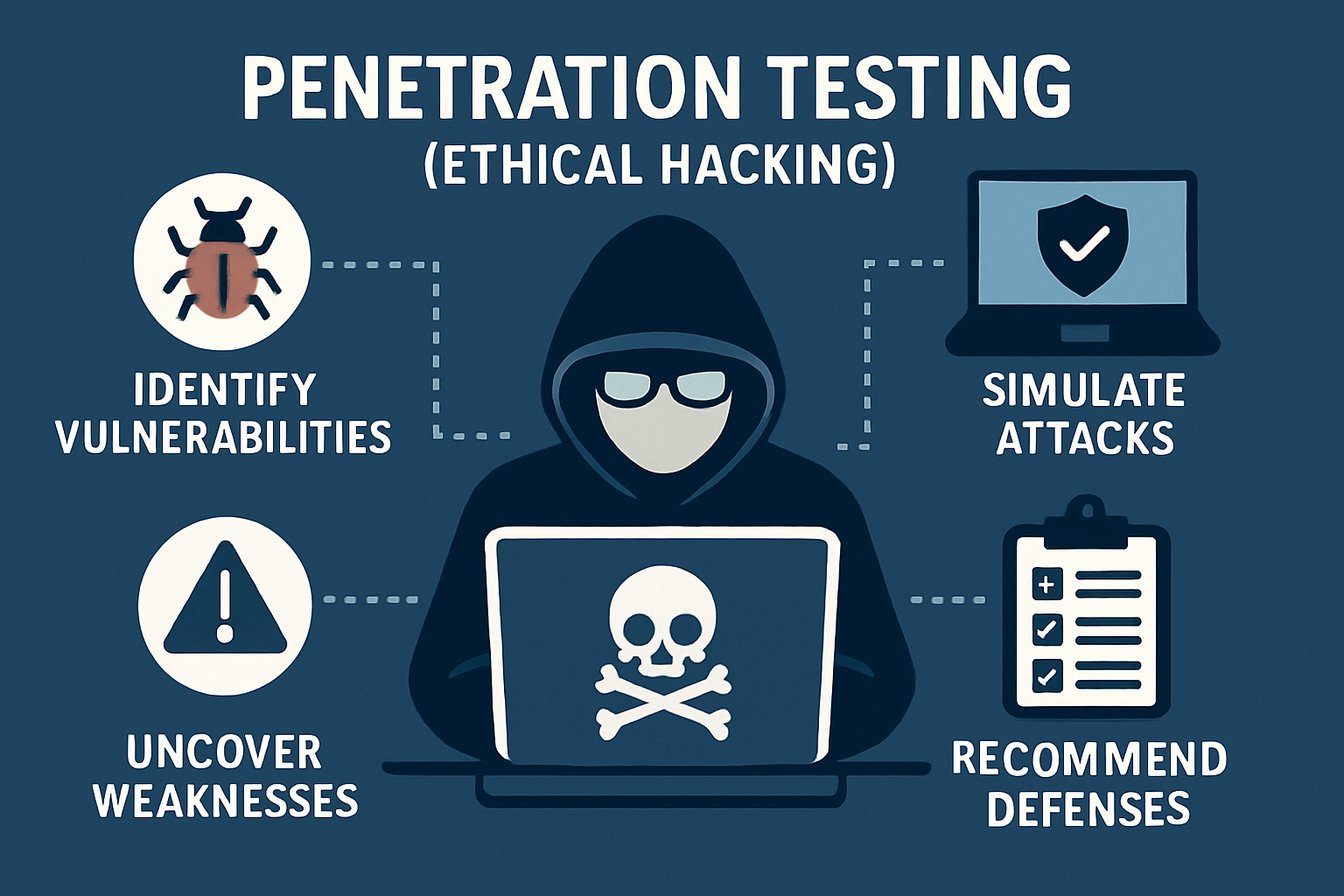
Annual vulnerability assessments are crucial for maintaining business security and compliance. Discover how they can safeguard your business against potential threats.
Understanding Vulnerability Assessments
Annual security assessments, including comprehensive penetration tests (pen-tests), are essential pillars of a resilient cybersecurity framework. These assessments simulate real-world cyberattacks on your organization’s infrastructure, applications, and processes, uncovering both known and unknown vulnerabilities that cybercriminals could exploit. By committing to an annual testing cadence, businesses take decisive action to mitigate risks, validate the effectiveness of existing security controls, and address gaps before they escalate into breaches.
Regularly scheduled assessments not only highlight specific technical weaknesses but also offer insights into your security program’s overall maturity and alignment with regulatory standards. Establishing these assessments as a routine, calendared event ensures that any discovered vulnerabilities are promptly prioritized and remediated, strengthening defenses against both current and emerging threats. This disciplined approach demonstrates industry best practice—maintaining a proactive security posture that adapts to evolving tactics and threat vectors, and reinforcing trust among your customers, stakeholders, and partners.
Vulnerability Assessments vs. Penetration Testing
One of the most common areas of confusion in cybersecurity is the distinction between a vulnerability assessment and a penetration test. While the terms are sometimes used interchangeably, they serve different—yet complementary—purposes.
A vulnerability assessment is like a wide-angle scan of your environment. Using both automated tools and expert review, it identifies known weaknesses such as unpatched software, misconfigurations, or weak access controls. The goal is coverage—ensuring nothing slips through the cracks. Assessments are invaluable for maintaining a current snapshot of your overall risk landscape and prioritizing remediation efforts based on severity.
A penetration test (or pen-test) goes beyond detection. Here, skilled security professionals emulate real attackers, attempting to exploit vulnerabilities under controlled conditions. A pen-test answers the critical question: If an adversary targets us, how far could they get? By simulating tactics like lateral movement, privilege escalation, or data exfiltration, pen-tests reveal not only whether vulnerabilities exist, but how they could be chained together to achieve real business impact.
Think of a vulnerability assessment as the diagnostic scan and the pen-test as the stress test. On their own, each delivers value. Together, they provide a comprehensive picture of risk: where exposures exist, and how those exposures could be exploited in practice. Organizations that combine both approaches demonstrate a more mature security posture—one that balances visibility with validation.
Executives and boards increasingly want assurance that security programs are both thorough and tested. Conducting vulnerability assessments and pen-tests on a regular cadence provides that assurance. Assessments identify the “what,” pen-tests reveal the “so what,” and together they create actionable intelligence to protect revenue, compliance, and reputation.
Red, Blue & Purple Teams: A Strategic Layer to Your Vulnerability Assessments
A robust cybersecurity strategy does more than just identify vulnerabilities—it structures how those vulnerabilities are attacked, defended, and learned from. Enter Red, Blue, and Purple Teams—an approach that complements annual vulnerability assessments and penetration tests by bringing in both offensive and defensive minds.
Role of the Red Team. Red Teams play offense. They think like attackers. Their mission is to simulate real-world threats: social engineering, adversary emulation, recon, and actual penetration of networks to uncover weaknesses that standard scans or pen tests might miss. When red-team engagements are aligned with your vulnerability assessment findings, they dig into the gaps with creativity and intent—revealing paths that adversaries could exploit.
Role of the Blue Team. Blue Teams are your defenders. They maintain the walls, monitor environments, respond to alerts, and recover from incidents. Their work involves log analysis, detecting intrusion attempts, patching, configuring defenses, enforcing least-privilege access, and ensuring the security framework is resilient. Penetration test or vulnerability scan findings feed their priorities.
Role of the Purple Team. Purple Teams bridge the gap. They ensure Red and Blue Teams don’t work in silos. Using insights from offensive testing (Red), they help reinforce blue-team responses, improve incident playbooks, and ensure that lessons learned translate into stronger, often immediate defensive improvements. Purple Teams facilitate joint drills, feedback loops, and strategic alignment so that vulnerabilities found are remediated, defenses are adjusted, and the organization’s posture becomes more holistic.
How This Enhances Your Annual Assessments.
Integrating Red/Blue/Purple team practices into your assessment cadence elevates vulnerability assessments and pen testing from periodic snapshots to ongoing, evolving security proof points. For example:
-
Deeper insight. Red Team work can expose chinked armor that even thorough vulnerability scans might overlook—misconfigurations, human weaknesses, or design flaws.
-
Stronger defenses. Blue Team response planning gets stress-tested, refined, and made more efficient because they are responding to simulated, realistic scenarios, not just the theoretical.
-
Faster remediation. Purple Team collaboration means feedback loops get shorter. Findings from pen-tests or red-team efforts are turned into action faster, with better prioritization according to actual risk.
Business Value & ROI. Organizations that pair annual pen tests with Red/Blue/Purple collaboration find greater return on security investment. They reduce dwell time for threats, increase readiness for incident response, strengthen compliance posture, and improve stakeholder confidence. It also helps with regulatory expectations: being able to demonstrate not just that you test but that you act, adapt, and continuously improve upon test findings.
Enhancing Security Posture
The importance of annual pen-testing cannot be overstated. By conducting these tests regularly, businesses gain critical visibility into previously undetected security gaps—ranging from outdated software and misconfigured network devices to user privilege mismanagement—that attackers could exploit for unauthorized access or data exfiltration. Annual pen-tests empower organizations to move from a reactive to a proactive cybersecurity posture, giving security and IT teams actionable intelligence to fix vulnerabilities before they escalate into significant incidents.
Beyond the technical findings, the annual cadence of pen-testing accelerates security program maturity, ensuring that defense strategies are continuously refined to address changes in technology, regulatory standards, and attacker tactics. This ongoing cycle of assessment and remediation reduces the likelihood of successful cyber-attacks while enhancing your organization’s preparedness to respond to rapidly evolving threats. Such a disciplined, proactive approach not only safeguards sensitive data but also sustains stakeholder confidence—demonstrating a measurable commitment to data privacy, regulatory compliance, and operational resilience. In a world where threats are constant and trust is paramount, making pen-testing an annual business priority is a foundational step toward securing your organization’s future.
Staying Ahead of Threats
In today’s dynamic threat landscape, staying ahead of cyber threats requires constant vigilance—and a willingness to continually adapt. Annual vulnerability assessments and penetration tests empower businesses to proactively identify new and emerging threats that might not have existed even a few months ago. As cybercriminals evolve their methods, deploying tactics such as zero-day exploits, advanced social engineering, and supply chain attacks, the safeguards you relied on last year may no longer be effective. By making regular security testing an organizational standard, you ensure that your cyber defenses respond to these ever-changing risks, closing exposure gaps and validating that controls are effective against current attack scenarios.
Committing to annual or more frequent testing introduces a level of discipline and accountability into your organization’s cybersecurity program. It enables your security and IT teams to examine the actual resilience of your applications, networks, and systems—from initial reconnaissance to potential exploitation—under realistic threat conditions. The knowledge gained from offensive security exercises, such as pen-tests, goes beyond surface-level assessments; it delivers clear, actionable intelligence about how your environment withstands simulated attack attempts. This allows IT leaders to prioritize remediation efforts according to true business risk and allocate resources strategically.
Ultimately, by identifying and addressing vulnerabilities before adversaries can exploit them, organizations not only minimize the risk of data breaches and service disruptions but also reinforce a culture of cyber resilience. This proactive mindset demonstrates your ongoing commitment to security excellence, ensuring your organization—and those who depend on you—remain protected in an environment defined by continual change and sophisticated threat actors.
Navigating Compliance Requirements
Compliance with industry regulations and standards is a crucial aspect of modern business operations, particularly in regulated sectors such as healthcare, finance, manufacturing, and technology. Regulatory frameworks, including HIPAA, PCI DSS, SOX, GLBA, and others, increasingly require organizations to implement rigorous security controls and undergo regular testing to verify compliance. Annual penetration tests and vulnerability assessments serve as clear evidence of your due diligence, fulfilling audit and documentation requirements set by both government agencies and industry-specific authorities.
By systematically conducting these security evaluations, organizations can identify control deficiencies, address policy gaps, and generate the audit trails needed to demonstrate compliance during external reviews. This proactive approach significantly reduces the risk of incurring fines, costly legal action, or reputational damage resulting from non-compliance or undetected vulnerabilities.
Moreover, consistently prioritizing compliance through regular assessments sends a powerful signal of trust to your clients, business partners, and stakeholders. It underscores your organization’s commitment to data protection, risk management, and adherence to industry best practices—factors that can differentiate your business in a competitive marketplace. Demonstrable compliance not only protects your business from regulatory penalties but also enhances your value proposition, strengthens relationships, and positions your organization as a security-focused leader in your field.
Proactive Risk Management
Reducing business risk is a primary goal of any cybersecurity strategy, and true risk reduction requires more than just reactive responses—it demands foresight, planning, and disciplined execution. Annual vulnerability assessments and penetration tests form the backbone of proactive risk management, enabling organizations to identify and address potential threats before malicious actors can exploit them. These evaluations provide detailed insight into technical exposures across your network, applications, and operational processes, empowering you to close gaps proactively and ensure that both known and emerging vulnerabilities are remediated swiftly.
By identifying weaknesses early, businesses can implement targeted countermeasures such as patching critical systems, reconfiguring access controls, updating security policies, and conducting user awareness training. This not only reduces the attack surface but also strengthens your overall security posture, making it significantly more difficult for adversaries to achieve their objectives.
Furthermore, proactive testing supports operational resilience by preventing the cascading impacts of data breaches, ransomware, or service outages. Avoiding incidents through early detection reduces the likelihood of regulatory investigations, loss of customer trust, reputational damage, and financial penalties. Regular, systematic testing is a vital safeguard for maintaining business continuity, ensuring that your critical operations, data assets, and client relationships remain protected—even as the threat environment evolves. In doing so, your organization reinforces its commitment to security best practices, builds stakeholder confidence, and safeguards its future growth.
How Our Expertise Can Help Your Business
At Cyber Advisors, we bring a legacy of award-winning security leadership backed by decades of hands-on experience with clients ranging from agile startups to global enterprises. Our elite, nationally recognized security team is at the heart of everything we do, providing unparalleled expertise in scheduling, implementing, and analyzing penetration tests and vulnerability assessments to keep your business resilient.
Through our recent strategic acquisitions of companies like White Oak Security and Stratum Security, we have further expanded our bench strength and capability footprint—integrating some of the best minds in offensive and defensive security into our organization. This expanded expertise now enables us to offer even deeper threat intelligence, advanced penetration testing methodologies, and consultative support tailored to the unique regulatory and operational challenges faced across healthcare, finance, manufacturing, technology, and more.
Whether you are a small business or a large enterprise, you will benefit from the collective strengths of a unified security team that combines real-world experience, technical excellence, and industry accolades. Our comprehensive cybersecurity solutions are purpose-built to protect your assets, ensure compliance, and safeguard your reputation. Trust Cyber Advisors—enhanced by the remarkable talent from White Oak Security and Stratum Security—to be your partner in achieving and maintaining a robust, future-ready security posture.
Schedule your annual pen-test today.
Don’t wait until it’s too late. Ensure your business is protected against cyber threats by scheduling your annual pen-test with Cyber Advisors today. Our team of experts is ready to help you identify and address vulnerabilities, keeping your data secure and your operations running smoothly.
Reach out to Cyber Advisors for an annual security assessment and pen-test implementation. Let us help you stay ahead of threats and maintain a strong cybersecurity posture.




